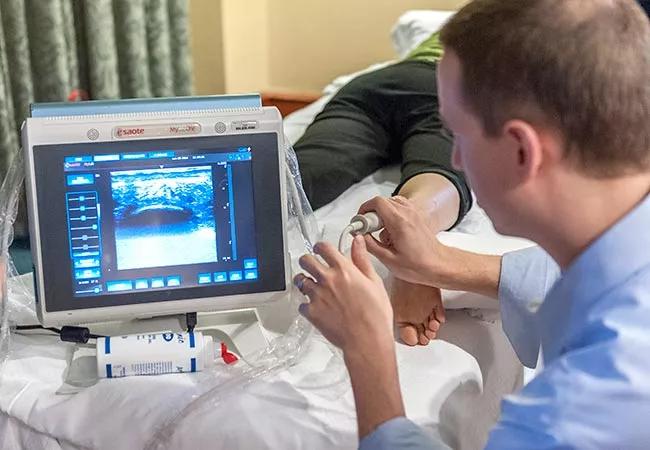Advertisement
Reliable and cost-effective tool for sports injuries

“At Cleveland Clinic, a team of sports and exercise medicine physicians and musculoskeletal radiologists consider ultrasound a shared interest,” notes Susan Joy, MD, a Cleveland Clinic sports and exercise medicine physician and Director of the Community Sports Health Network. “We have a range of imaging choices relevant to athletic injuries or overuse, and we regard musculoskeletal ultrasound as an important tool in addition to CT, X-ray and MRI.” Dr. Joy adds, “Our goal is to use the most appropriate imaging modality for each injury.”
Advertisement
Cleveland Clinic is a non-profit academic medical center. Advertising on our site helps support our mission. We do not endorse non-Cleveland Clinic products or services. Policy
Dr. Joy answers some questions on musculoskeletal ultrasound and qualities that set it apart from other imaging modalities.
Musculoskeletal ultrasound has seen significant use over the past 10 years. We now regard it as a front-line diagnostic tool to (1) evaluate tendons, ligaments and muscles around the ankle, knee, hip, hand, elbow and shoulder for acute injuries and other pathologies; and (2) guide therapeutic injections and aspirations of many joints, muscles, tendons and nerves.
The clinician uses a handheld transducer that is connected to an ultrasound machine. Some units are larger, on a rolling cart, and some are much smaller and easily portable, like a laptop computer. A musculoskeletal ultrasound can take place at the patient’s bedside, in the exam room, or outside the medical building in training rooms or on the sidelines. As the clinician passes the transducer over the target area, images appear in real time on the screen. To maintain good contact with the skin, the clinician or sonographer uses gel, like with any other ultrasound. Some special positioning is required to see some musculoskeletal structures well, but these positions are held briefly compared with those required for other modalities, such as MRI.
Dynamic imaging is a very important aspect of musculoskeletal ultrasound. Sometimes, a patient’s symptoms are only reproduced with movement. Ultrasound can allow for real-time imaging while the patient reproduces his or her symptoms. This is not possible to the same degree with other imaging modalities.
Advertisement
Musculoskeletal ultrasound is fast, low-cost and safe. It provides immediate visualization and allows for dynamic imaging. For many superficial musculoskeletal soft tissues, ultrasounds offer the most high-quality images available. An added feature of ultrasound is the ability to evaluate for active inflammation by detecting increased blood flow in soft tissues using Doppler imaging. Another benefit is the proximity of clinician and patient, which encourages their interaction.
Musculoskeletal ultrasound is very useful for procedures, allowing for real-time visualization of the needle and the target during the procedure. Ultrasound can be used for specialized injections into joints and soft tissues, as well as for aspiration of fluid from joints or soft tissues for testing. For therapeutic injections, it is crucial that the medication be placed in the correct location. Ultrasound ensures that this can happen.
Unlike CT and X-ray, musculoskeletal ultrasound does not expose patients to radiation. It costs less than MRI and has been accepted by insurance carriers as a valuable imaging modality. Musculoskeletal ultrasound is also safe for those with metal implants or stimulators who are being examined or who are in the treatment area. It is quiet and more comfortable for claustrophobic patients and obese patients.
It is important to note that musculoskeletal ultrasound cannot penetrate bone. Thus, problems involving the bones themselves and deep joint structures warrant X-ray and sometimes MRI or CT for further evaluation.
Advertisement
Injection accuracy is key. Real-time guidance allows the clinician to observe treatment progression from inserting the tip of the needle to advancing through overlying tissues to reach the target and aspirating fluid or injecting medication. With constant visualization, the clinician can change the injection approach, if necessary, to avoid unintentional damage to vessels and nerves and to determine whether accurate delivery is achieved. Musculoskeletal ultrasound may be used post-procedure to assess healing by noting the treated tissue’s organization and blood flow/inflammation status.
Findings from various research studies show that musculoskeletal ultrasound provides improved treatment injection accuracy, better outcomes and, compared with MRI, improved patient comfort and pain relief. Also, the addition of ultrasound guidance improves accuracy during shoulder injection procedures compared with those without the ultrasound guidance. A study comparing ultrasound guidance to fluoroscopy reported significantly less procedural time with ultrasound for the injection of the glenohumeral joint. There is evidence that musculoskeletal ultrasound reduces diagnostic errors and reduces the number of patients who need advanced imaging, such as CT and MRI.
Not every rotator cuff needs an MRI, and not every injection needs an ultrasound. Our job is to determine how to best use the technology and resources we have to ensure the best possible patient care.
“Our multidisciplinary team considers musculoskeletal ultrasound an increasingly popular technology with great potential,” says Michael C. Forney, MD, a musculoskeletal radiologist in Cleveland Clinic’s Imaging Institute. “We are working together on improving not only clinical delivery of services to our patients but also education of our staff and trainees. Our goal is to streamline use of imaging and interventions to improve diagnostic accuracy and treatment, thereby positively affecting patient outcomes.
Advertisement
Advertisement

This rare disease usually manifests as a firm, painless mass that is growing

Gamers are athletes who can benefit from athletic training

More report a clinically meaningful change in function at 90 days compared to patients with lower BMI

Patient climbs Mount Kilimanjaro 8 months after surgery

A behind-the-scenes look at Cleveland Clinic’s role as medical services provider of the 2023 Summer Series

Sports medicine pioneer John Bergfeld, MD, shares how orthopaedics has changed since doing his first ACL repair in 1970

Researchers hope it may one day help patients avoid explantation surgery

Rest is often not the best care for gamers’ overuse injuries